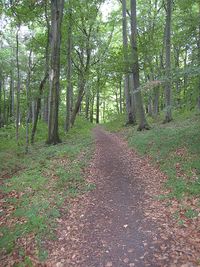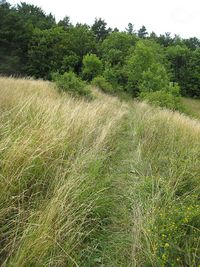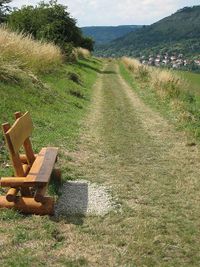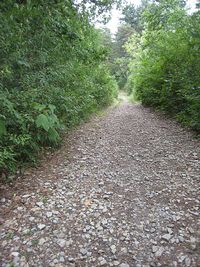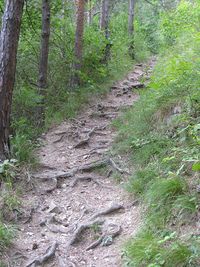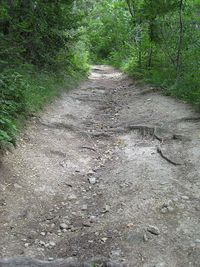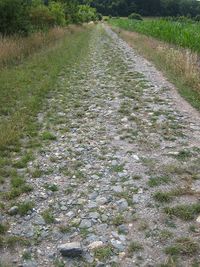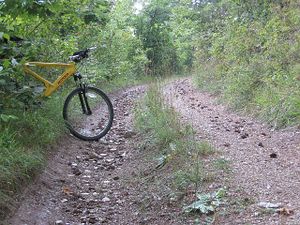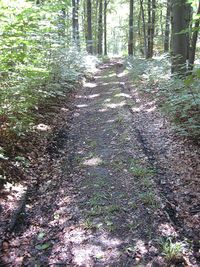Talk:Accepted features/Smoothness: Difference between revisions
Harry Wood (talk | contribs) (quantizing comfort) |
|||
| Line 326: | Line 326: | ||
:Maybe what you want in the end is, like it was said near the end of : [[Proposed_features/Smoothness#Another Proposal]] is to describe the "comfort" of the road. What (I think) we want here, is the "usability" or "passability" of a road. Even if I need to drive at 5km/h to go with my car, that's a possibility my routing program should take into account. |
:Maybe what you want in the end is, like it was said near the end of : [[Proposed_features/Smoothness#Another Proposal]] is to describe the "comfort" of the road. What (I think) we want here, is the "usability" or "passability" of a road. Even if I need to drive at 5km/h to go with my car, that's a possibility my routing program should take into account. |
||
::I like this new proposal. But if this page is about the usability or passability, is there any other proposal-page for the comfort of the road? There are so many resembling proposals now, that i don't want to open a new proposal again... --[[User:TEL0000|TEL0000]] 02:33, 24 August 2008 (UTC) |
::I like this new proposal. But if this page is about the usability or passability, is there any other proposal-page for the comfort of the road? There are so many resembling proposals now, that i don't want to open a new proposal again... --[[User:TEL0000|TEL0000]] 02:33, 24 August 2008 (UTC) |
||
:::Same issue from a roller-blading point of view. A road with 'excellent' smoothness would be great (a fun place to go to especially for skating perhaps), but then a road with 'good' smoothness might just be more uncomfortable on roller-blades. Seems like just a problem with the descriptions. Maybe 'uncomfortable for type x' bits should be added the description. -- [[User:Harry Wood|Harry Wood]] 15:39, 22 September 2008 (UTC) |
|||
: In you'r proposal, the advantage I see for routing is to decide between different roads wich is faster, then you'r "maxqspeed" could do the work [[User:Sletuffe|Sletuffe]] 00:45, 24 August 2008 (UTC) |
: In you'r proposal, the advantage I see for routing is to decide between different roads wich is faster, then you'r "maxqspeed" could do the work [[User:Sletuffe|Sletuffe]] 00:45, 24 August 2008 (UTC) |
||
Revision as of 15:39, 22 September 2008
Ok, I agree with the smoothness tag as proposed in you'r tab, because I need something like that for mountain track roads ( saying which vehicule you need at least to drive on it ) Sletuffe 16:28, 16 May 2008 (UTC)
Even being new at OSM: from my view as a biker and inline-skater smoothness is a very practical solution in conjuntion with surface Pmurk65 27 May 2008
smoothness and surface
I dislike the dependencies between the proposed smoothness and the surface key. If I read your list correctly, a way with surface=cobblestone and smoothness=bad is illegal? I'd certainly like to distinguish between various grades of cobblestoned road. In my opinion, smoothness without surface is pointless, hence I'd rather a smoothness key refined surface, so you get excellent or good or intermediate paved roads, good to catastrophic cobblestoned roads, etc. So how about a key smoothness=0 (default), +1, -1 to refine a base smoothness for the type of surface? Robx 07:11, 30 May 2008 (UTC)
- This dependency was not my intention. The surface descriptions in the second column are EXAMPLES, not used for definition. The smoothness of a way should be assessed solely based on the usability of that way by the vehicles I mention, NOT based on the surface. This is my whole point: as a user of a certain road or path I am only interested wether I can drive on this road or not. If I sit on a racing bike, I am not interested wether the surface of a way is cobblestone or mud, just wether it is smooth enough to be used with a racing bike or not. I changed the proposal to make that clear (hopefully). With your proposal of a refined surface key, it gets very difficult to draw usage-specific maps (e.g. for racing bikes), since there is a potentially infinite number of surface values. Imagine a piste on a salt lake -- with the surface key it would read "surface=salt", which would have no meaning before the key is integrated into all the renderers and Garmin type files and whatever. With "smoothness=excellent", it would instantly show up everywhere as usable with a racing bike, which is my intention. --Chrischan 11:05, 1 June 2008 (UTC)
- I'm beginning to like the proposal. It doesn't store all relevant information, but it's a good start, and appears to be clearly defined. I've started tagging some roads around here, the better cobblestoned roads with smoothness=intermediate and the awful ones with smoothness=bad. Also some really smooth paved roads with smoothness=excellent. I'd suggest adding some default values: A road should have a default of smoothness=good given its surface is paved or unspecified. A road with surface=cobblestone should default to smoothness=intermediate. A track should probably default to intermediate also. Robx 20:09, 2 June 2008 (UTC)
- Perhaps an additional value of "unknown" would be best as a default? I've even been on an interstate highway (motorway) which is definitely smoothness=bad, or maybe smoothness=intermediate if you're feeling generous. Just anecdotal, but I think it's a bad idea to imply the smoothness based on the highway (or even surface) classification. --Hawke 21:26, 2 June 2008 (UTC)
- I'm sure those exist, but they're certainly the exception. A default of unkown (or rather, no default), includes in the smoothness tag also the information whether the way has been surveyed for smoothness, which may be a good idea. But I'd rather not add thousands of smoothness=good tags and rather state somewhere that I've surveyed a given area for smoothness. Robx 18:37, 8 June 2008 (UTC)
- Perhaps an additional value of "unknown" would be best as a default? I've even been on an interstate highway (motorway) which is definitely smoothness=bad, or maybe smoothness=intermediate if you're feeling generous. Just anecdotal, but I think it's a bad idea to imply the smoothness based on the highway (or even surface) classification. --Hawke 21:26, 2 June 2008 (UTC)
- I'm beginning to like the proposal. It doesn't store all relevant information, but it's a good start, and appears to be clearly defined. I've started tagging some roads around here, the better cobblestoned roads with smoothness=intermediate and the awful ones with smoothness=bad. Also some really smooth paved roads with smoothness=excellent. I'd suggest adding some default values: A road should have a default of smoothness=good given its surface is paved or unspecified. A road with surface=cobblestone should default to smoothness=intermediate. A track should probably default to intermediate also. Robx 20:09, 2 June 2008 (UTC)
Subjective
I've never like subjective tags such as this. This is why tracktype=* never got anywhere, as it is not obvious what the difference between "bad" and "intermediate" is. For instance, the roads where I live are terrible, but saying as they're all like that, should it be smoothness=bad or smoothness=intermediate? Bruce89 14:19, 30 May 2008 (UTC)
- I like it, as long as there are usable guidelines for how to tag. "suitable for roller skates" and "suitable for mountain bikes and 4-wheel-drive automobiles" is quite good, IMO. --Hawke 15:16, 30 May 2008 (UTC)
- In my opinion, tracktype=* never got anywhere because it does not describe a singular property of a way, but a combination of properties. Smoothness, although as far as I know not being a standardized physical property, could even be measured physically (I think of a wheel of defined size, measuring the vertical deflection while being dragged along the way). Obviously, this would be very unpractical. But when you honestly try to classify the roads you know into that scheme (based on wether you would drive on it with the vehicles I mention), you will see that the classification is pretty unambiguous in *most* cases. But I think this is very similar to the width of a road: although it is a physical property, few people would actually bring a rule and measure the width, most people would guess. Still it is very good to know wether the width is 2m or 20m, or wether the smoothness is excellent or horrible. --Chrischan 11:36, 1 June 2008 (UTC)
Catastrophic?
I have to say that I'm not so sure about "catastrophic" for the lowest value, it doesn't seem to fit with the others. I suggest "horrible" as an alternative. I'd support the proposal though. --Hawke 15:20, 30 May 2008 (UTC)
- I know what it means, I just don't think it's a very good word to use for a value here. --Hawke 17:06, 30 May 2008 (UTC)
- Hawke, why do you think "catastrophic" does not fit with the others? I actually do not care about the values at all, I just want the schema ;-). But maybe I should add Alvs idea to have one more tag essentially saying "no wheeled access possible" beyond the 4wd access value. --Chrischan 11:42, 1 June 2008 (UTC)
- It just doesn't fit with the rest, in my mind. "How was that sandwich you ate today?" "Oh, it was catastrophic!" doesn't work. Or -- "Hey, I want to go for a ride on Foo Lane; how's the surface quality?" "Oh, I wouldn't ride there, it's catastrophic!". "Catastrophic" to me would give a degree of badness to something that was already bad ("I had a catastrophic accident on my bicycle today").
- I do like Alv's idea of a sixth grade beyond the 4wd level. Perhaps "impassable" would work, especially if this is intended to apply to wheeled vehicles only. Bipeds are quite good at navigating obstacles, and if it's impassable by them, we probably shouldn't be mapping it as any sort of routeable type.--Hawke 16:26, 2 June 2008 (UTC)
- How about "very bad", then catastrophic as the lowest value. Otherwise it's too big a jump from grass to mountain tracks. --OliverLondon 16:28, 2 June 2008 (UTC)
- I started mapping tracks as I was hiking this week end with the smoothness tag in addition of the highway=track tag, and it turns out that I mapped a lot of tracks with the lowest possible quality ( smoothness=catastrophic ). But I doubt any 4wd could pass the tracks I went to so I missused that tag because It lacks "above" (or below ;-) ) catastophic. So I wonder why those tracks were there If no 4 wheels vehicules can use them ? The answer to my question came 10 minutes later as we crossed their way : 2 differents 4 wheels vehicules, a tractor and a "Quad" ( in french ). So, I am in favour or adding a "horrible" or whatever we should call it level to increase to 6 the number of smoothness tags in the goal of mapping what can drive on after a 4wd. To my mind, Mountain Bike can drive where 4wd ( not the army ones) cannot, the "horrible" tag should fit for 4wd and the "catastrophic" tag for Mountain bike & Tractors & "quads" Sletuffe 13:34, 3 June 2008 (UTC)
impassable ?
ok this looks better because it's less subjective than catastophic, but I don't think it's ok either. Why ? Answer this : how could a track be impassable by 4 wheeled vehicules ? It cannot, by the fact that it was created as a track in the goal to make passing possible what's worse than horrible ? I'm not a native english speaker ? or could we insert a "very_bad" between bad and "horrible" ? Sletuffe 15:43, 4 June 2008 (UTC)
- I think impassable wouldn't be applicable to tracks. On a footway, it would say that it wouldn't be passable by mountainbike. It's not a value that would be used much, mostly there for completeness. Robx
Laterally varying smoothness
- In fact, it doesn't need to be specified. The proposal is quite usable the way it is right now. I'd suggest voting on this as is, and then considering refinements such as smoothness=bad plus smoothness:left_border=good plus left_border:surface=painted_paving_stones. If you encounter a way that doesn't quite fit, add a note or invent some appropriate tag. Robx 18:32, 8 June 2008 (UTC)
Vote? (and what about sand)
Since discussion seems to have died down without major objections, how about taking this to vote?
I did come across a minor problem: In the local forests, there's some deep sandy tracks (partly bridleways). Since they're barely passable by wheeled vehicles, I'd tag them smoothness=bad, but arguably they're really quite "smooth". Robx 07:42, 30 June 2008 (UTC)
- Same as you, I'm using it for a while now, and would be sad to see it dropped ;-)
- For your remark about "smooth sand" but passable ( only by 4wd ? then I would have tag it smoothness=horrible ), I forsee some confusion just because of the name "smoothness". If I understand this proposal correctly, and as I was saying here before Chrischan transformed it into a nice proposal, the real goal of it, as mentionned here in the proposal : The smoothness of a way should be assessed solely based on the usability of that way by the vehicles mentioned above, NOT based on the surface properties
- In clear, even if it is a perfectly smooth surface such as a wall, because it isn't passable then it shouldn't be tagged with smoothness
- Ok my example is bad because we don't tag walls, but I'm sure every one get the point Sletuffe
Accessibility / Usability?
I like the idea behind this proposal: "This is my whole point: as a user of a certain road or path I am only interested wether I can drive on this road or not." What I do not like are the names. If what you are after with with this tag is whether you can use a road with a particular type of vehicle and not how smooth the surface is (this is just a means to indicate whether you can use the road) than I think the name should be rather accessibility or usability. This is also why I proposed to extend the access tag to cover the semantics but it seems people prefer to reserve this tag for legal access restrictions. Something like accessibility=(car|hc|4wd|tractor) would work perfectly for motorized vehicles and is actually the way how it is done in most maps that I know. It has also the benefit of largely resolving the sand problem as well as the discussion about subjective scales (what precisely is the difference between bad and intermediate etc.). Above all the meaning will be clear for the users of the map (the meaning of accessability=HC is much more obvious than smoothness=intermediate). The only problem I see is that things like roller blades only interested in excellently smooth pavement will not be covered anymore. But such "vehicles" are really rather interested in the surface property and should be covered by the surface tag. Ukuester 15:58, 4 July 2008 (UTC)
- I agree with you too, what we really need more than "is it made of grass, sand, cobblestone, stones, asphalt, smooth asphalt, asphalt ( that the surface tag can handle) is the usability of a way, and I feel that "smoothness" doesn't serve it well ( anyone comming very fast to this proposal would think it's intended for roller, skate or jogger ). Also I don't want to forget them, it's to my mind a secondary need.
- You are saying it would bann "roller blades" why not ?, if I continue your idea, why not use accessibility=roller_blades ?
- (by the way what is an HC ? )
- I would prefer usability rather than accessibility, and would propose something like :
| Proposal | usable by | minimum supposed surface |
|---|---|---|
| usability=roller | roller blade/skate board and all below | smooth asphalt or equivalent |
| usability=sport_car | sport car/racing bike and all below | asphalt or equivalent |
| usability=car | city bike/normal car and all below | none |
| usability=4wd | 4wd and all below | none |
| usability=tractor | tractors/quads/tanks/mountain motorcycle/Mountain bike | none |
- When reading my table, I might be agreeing with you that the 2 first might well be dropped and returned to the surface tag. But not sure because maybe someone will imagine a different surface type than asphalt where roller could still go.
- The only thing I am not happy with in this table is the fact that the tag refers to one and only one vehicule while I'd like to refer to a "group of"
- example, my "car" would better, but longer, be "any_vehicule_group_that_can_drive_where_a_car_can_drive"
- Usability Usability ! that what counts.
- using surface=asphalt and saying rollers can use it will fail when later someone add à surface tag that is different but still usable.
- Is it easy to see that I hate the surface tag, don't use it, and don't understand the need for it ?
- My point of vue might also be transposed to the way the access tag is used. We should think in terms of "group of vehicule sharing some properties" and "group of surface type sharing some properties" or else a routing program ( isn't it what we want in the end ? ) is unable to take into account all tags and variation that are added all the time to those tags.
- HUGH !, this is the friday thought
Sletuffe 18:51, 4 July 2008 (UTC)
- HC stands for "high clearance". For most tracks that a passenger car can not navigate you wouldn't need 4WD but simply a sufficient high clearance which some 2WD Jeeps have. The typical hierarchy for unpaved/dirt roads in the US (where this type of road is much more common than in Central Europe is "any passenger car can use" - "requires high clearance" - "requires four wheel drive" (example). I'm fine with using "usability" instead of "accessability" to make a more clear distinction to "access". I like your scale except that I would want to have hc added between car and 4wd. The fact that groups of vehicles are meant instead of particular vehicles should be made clear in the documentation of the tag. I would like to see a comment by Chrischan though. :-) Ukuester 11:58, 7 July 2008 (UTC)
This sounds like a totally separate proposal from Smoothness. You might want to create a new proposal and move this discussion over to it. --Hawke 16:38, 7 July 2008 (UTC)
- I disagree. According to the proposal the rationale behind smoothness is "This is my whole point: as a user of a certain road or path I am only interested wether I can drive on this road or not." I tried to make this more explicit than it was in the original proposal. Please explain why you think that this is totally separate. Right now we have a proposal surface, another proposal additional surface values, a third proposal tracktype, and a fourth proposal smoothness which are all closely related. I don't think a fifth proposal usability will make thinks any better. Ukuester 07:34, 8 July 2008 (UTC)
- I was mostly referring to Sluteffe's table, which is effectively another proposal. Your "accessibility" tag is also another proposal. --Hawke 06:01, 10 July 2008 (UTC)
- I also think this discussion should stay here, because indeed it is what I intended with this proposal. Actually something like this was one of my first thoughts. But then I decided to propose it the way I did, because I think "smoothness" is exactly what I want to describe. With the tagging scheme above, I see two problems:
- as mentioned above, I would like to address the "smoothness" independent of a particular type of vehicle. Ofcourse it could be mentioned in the documentation that a way for racing bikes should be tagged as "sport_car", but people only into biking would probably not start using this tag. Likewise, people driving in cars would probably not start tagging something as "roller_blade", because they think this is something for the roller blade crowd.
- More important, we get into conflict with other tags. Many people might imply that they can use a way with "Usability=sport_car" with their sports car, although it might be a road without car access ("access=no"). It would also be very strange to tag a 50cm wide path in the alps with "usability=4wd" (although it definitely can't be used by a 4wd), only because I want to make clear that I can use it with a mountain bike. -Chrischan 20:29, 8 July 2008 (UTC)
- The 50cm 4WD path is a point well taken. Unfortunately, you can also turn this argument against your original proposal. How do you tag a 2,50m wide track which has two very smooth drive traces but requires HC because the cross cut profile of the track looks like this: __x^x__ (smooth traces left and right but a something in the middle that would cause every passenger car to hit the ground)? I'm lacking the proper English terms for this but such tracks are not uncommon. If you tag it with smoothness=bad people driving in cars will know they can't use it but people riding city bikes will assume they can't use it either, although they actually might be well able to do so. To me it looks as if usability by bikes and cars (not to speak about other types of vehicles) might actually require different scales. :-/ Ukuester 08:20, 9 July 2008 (UTC)
- I agree with what Chrischan says, and disagree that you've made that argument against the original proposal. IMO That would call for another access tag (high_clearance=* or access:high_clearance=* perhaps? I think naming the values after particular modes of transport, such as accessibility=sports_car is nonsensical because of the complications that arise when you see a way tagged like that but which you can't take a sports car down. "bad" doesn't have this problem, and as long as objective standards are used for deciding what a "bad" or "good" smoothness is, it doesn't have the ambiguity that the original post was concerned with. --Hawke 06:01, 10 July 2008 (UTC)
- The question the proposed tag is supposed to answer is whether I will be able to use a particular road/track/path with a particular vehicle. Now how do you use smoothness to tag the track described by me above and make clear that it can be used by pretty much any type of bicycle but only by cars that posess high clearance. According to the table on the definition scale its impossible (the reason is that there is no complete ordering among vehicle types such that one vehicle can use all tracks usable by a "larger" vehicle). Of course a car specific tag clearance=* would do the job but the need of an additional tag suggests that the proposal is unable to really answer the question it is supposed to answer. It seems to me that usability by roller skates and racing bikes (and probably trecking bikes) could be handled resonably well by the surface=* as well as the smoothness=* tag. To know whether I can use a footpath with my mountain bike I would need to know the maximum steepness (not covered by neither smoothness=* nore surface=*) and the amount/existence of "steps", big rocks etc. (somewhat covered by smoothness=* but rather not by surface=*). Actually, for mountain bikes some scale denoting the technical difficulty similar to the proposed hiking scale might be usefull. For cars I need to now whether I need 4WD (related to the steepness and the surface) and whether I need HC (related to the existence of clefts, rocks, etc.). Both is not fully covered by neither smoothness=* nor surface=*. To me it seems that all these aspects cannot be squeezed into a single tag because the question of usability is multidimensional. The question now is, whether we are better of with smoothness=* (and some additional tags) or with usability=* with multiple values listing the vehicles able to use a road/path or with splitting all the information about a highway in multiple tags as proposed below. I agree that in any case we should and would not tag a smooth footpath with usability=sportscar and that we would not list all vehicles able to use a particular highway but make reasonable defaults/assumptions (e.g. any highway usable by a passenger car can be used by a trecking bike). Ukuester 10:02, 10 July 2008 (UTC)
- I agree with what Chrischan says, and disagree that you've made that argument against the original proposal. IMO That would call for another access tag (high_clearance=* or access:high_clearance=* perhaps? I think naming the values after particular modes of transport, such as accessibility=sports_car is nonsensical because of the complications that arise when you see a way tagged like that but which you can't take a sports car down. "bad" doesn't have this problem, and as long as objective standards are used for deciding what a "bad" or "good" smoothness is, it doesn't have the ambiguity that the original post was concerned with. --Hawke 06:01, 10 July 2008 (UTC)
- The argument here seems to be that the proposed smoothness=* isn't enough to tell whether a given way is usable by a car with a certain amount of ground clearance. My proposed solution:
- Reword the definition of smoothness=* so people don't think it's the be-all and end-all in usability-tagging. It just says whether a way is smooth enough to drive with a given class of wheeled vehicle.
- Propose a separate tag clearance=* or whatever that states how much ground clearance a four-or-more-wheeled vehicle needs to use the given way.
- In my opinion, smoothness=* is well-defined as is, providing a nice balance between detail and simplicity. It's a usable tag (I've been using it a lot already), and if there's some special cases it doesn't cover, so be it. Robx 10:53, 14 July 2008 (UTC)
- Ok then, we have to move forward. I'm ok with the name "smoothness" also I'm still scared about confusion, but a nice description might do the work. ( I also suggest to remove the "surface examples" colum to minimise confusion ).
- Ok also not to use "vehicule centric" tags and stay with excellent/good/intermediate/bad/horrible
- I also accept that we cannot "as is" deal with left/center/right changing smoothness, but other tags might be created for that purpose
- If the global idea is ok for most people here, I think we could move to voting
- I however d'like to point some refinement :
Sletuffe 15:53, 15 July 2008 (UTC)
- Fair enough. I added a lot of pictures that can be used for illustration (also for the limits of this proposal). Ukuester 18:36, 20 July 2008 (UTC)
Missing vehicules
Also I'm globaly happy with the main table I want to add refinement in the goal of not forgetting some vehicles while keeping actual compatibility.
- Has Ukuester mentionned a car with High clearance cannot fit in any tags but is able to pass ways where normal car cannot while it is not able to pass where a 4wd can.
- I also think tractors/quads/Trials are not taken into account and we might loose, in the mountains, special usability ( maybe also contributors from forest managers ) ONF (france )
Here is my proposal :
| Proposal | usable by : |
|---|---|
| smoothness=excellent | roller blade/skate board and all below |
| smoothness=good | racing bike and all below |
| smoothness=intermediate | city bike/sport cars/wheel chair/Scooter and all below |
| smoothness=bad | trekking bike/normal cars/Rickshaw and all below |
| smoothness=very_bad | Car with high clearance/ Mountain bike without crampons and all below |
| smoothness=horrible | 4wd and all below |
| smoothness=very_horrible | tractor/ATV/tanks/trial/Mountain bike |
| smoothness=impassable | ??? no vehicles ? |
Comments :
- I still have problem understanding what impassable will be used for
- I think mountain bikes can go where 4wd have to stop ( dispending on pilote's legs ! )
Sletuffe 15:53, 15 July 2008 (UTC)
- I guess impassable would mean no vehicles. I added a lot of example pictures (that I would like to see how they would be tagged) and one of them cannot be navigated even on a mountain bike. If you are very good, you might be able to go it down (although it's pretty tough) but certainly not up. Ukuester 18:33, 20 July 2008 (UTC)
Don't try to fit the surface description into one key, use more objective tags
I don't think this tag alone describe the surface better than the other tags for surface and tracktype. This may fit for wheeled vehicles somehow, but why use the subjective keys and don't use directly the size of wheels that works on this surface?
I suggest to use a combination of tags to describe the surface. Some of the tag may even be subjective. The usability tag above is a start. We may extend the surface tag from paved/unpaved to describe better if it's sand, asphalt, concrete, stone, grass.
- example: An old shabby residential road
highway=residential, width=5, surface=asphalt, smoothness=coarse, usability=bike, clefts=yes, minwheelsize=25cm
- example: A narrow track with paved surface in good condition
highway=track, width=3, surface=paved, smoothness=fine, usability=roller, clefts=no, minwheelsize=5cm
Of course you don't need all those tags for each road. You can assume some defaults. The last example don't need the usability tag, it should be clear from other tags that the surface is usable for skates --Andy 14:20, 9 July 2008 (UTC)
- Nobody's claiming that smoothness=* alone describes the surface of a way completely. It can be used independently of the current tracktype=*. You're free to propose additional tags for capturing the type of surface more exactly. Robx 10:57, 14 July 2008 (UTC)
- Ok, see, this is maybe a case where someone missunderstood the smoothness=* tag. smoothness=* is not intended to describe the surface of a way. It's just only about usability.
- I however note that your idea about a tag called minwheelsize=* + using width=* could maybe solve our problem
- But I am not completly sure that size of weels is enough. Maybe a F1 with big wheels while not be able to drive on a track. Adding the surface would help, but then we would loose the easy use of smoothness=* describing usability in one tag
Sletuffe 16:05, 15 July 2008 (UTC)
- Most of the vehicles mentioned in the table above (sports cars, racing bikes, mountain bikes, 4WD cars, ...) have the same wheel size. Thus, I don't think wheel size is going to help much. But your comment "smoothness is not intended to describe the surface of a way. It's just only about usability" highlights that surface is what people think when they read smoothness. :-/ Ukuester 18:24, 19 July 2008 (UTC)
Don't invent too many similar tags
I agree we really need a more general tag describing the surface conditions of the highways like this smoothness.
- I would preffer, if it would deprecate the tracktype. Would be a mapping reasonable like grade1->good ... grade5->impassable?
- I'd like to deprecate tracktype too, but I'am scared there is no mapping at all between smoothness & tracktype and not the same goal in the end.
- I don't personnaly understand the usage of tracktype, and it seams to me many are not using it the way it was intended to be used by using it as a scale to describe how hard is it to drive on a track. Usage which should be better covered by the smoothness tag.
- If you look closely at the describtion, you'll find grade1 is duplicate of highway=unclassified
- and that grade3 to grade5 is very vague with many terms like "A mixture of", "quite compact", "tire marks" compared to "subtle tire marks". All that seams very confusing and subjective to me.
- For exemple, should I tag a track with grade4 in winter and then grade5 in summer when grass has grown ?
- For me, tracktype is an "in between" surface tag and smoothness tag Sletuffe 11:19, 10 August 2008 (UTC)
- What about the hiking tag? Shouldn't there be only one tag describing the usabillity for wheeled vehicles and for use by foot?
- I don't think so, we shouldn't bother people who don't care about hiking by creating a single global tag Sletuffe 11:19, 10 August 2008 (UTC)
- But tracks are quite often used by vehicles and by foot. So you need two different tags for describing the same condition of the same way. I would preferre a mapping of the hinking values to the smoothness and probably extend the smoothness for ways where riding is not possible any more but where we can still make a difference for usage by foot.--De muur 08:41, 11 August 2008 (UTC)
- And what default value shall be assumed, if no smoothness tag is set? Default value for surface is paved, so it could be either Excellent or Good.--De muur 11:39, 7 August 2008 (UTC)
- I suppose something like "bad" for a track, "good" for other highway and "excelent" for cycleway should be enough Sletuffe 11:19, 10 August 2008 (UTC)
Examples
Some examples to discuss and illustrate the taggings.
| Quite "smooth" can be used by any type of bike. Obviously not wide enough for motorized vehicles. | |
| Same path as above a little down the road. Still quite "smooth" but much narrower. Can still be used by any type of bike. Obviously not wide enough for motorized vehicles. | |
| Still same path as above which crosses a meadow now. Not very "smooth" anymore. Could be used by mountain bike (not comfortable though) and probably with HC cars. | |
| Another track covered with grass, but short and thus quite smooth. Can be used with a passenger car and a trekking bike. | |
| Path covered with medium rough gravel (3cm pieces). Maybe ok with Trekking bike and above. | |
| An example of an impassable (except on foot) path. Heavily washed out, exposed roots and rocks. Cannot be navigated even on a mountain bike. | |
| An example of a pretty rough track. Quite eroded, exposed roots and rocks. Can be used with a mountain bike and a high clearance vehicle. Depending on the steepness and the weather conditions the track may additionally require 4WD. | |
| Another example. Not eroded as the one above, simply covered with very rough gravel/rocks. Can be used with a mountain bike and probably even a passenger car, not very comfortably so though. | |
| This track is smooth in the direction of use (can be used by a trekking bike) but has an eroded cross profile. The left, downhill facing side of the track is maybe 30cm lower than the right half. This track requires exceptional high clearance. This becomes particularly obvious if you look at the far end where the track turns right. | |
| The same phenomenon, but a very different type. This track is smooth in the middle and can be used by any type of bike. On the outskirts it is muddy, thus requiring high clearance if navigated with a car. |
Another proposal
I think the original proposal has not enough values. And for non-english speaking people it is hard to find the difference. I'm very interested in this probosal, because our car has a very hard suspension, and it would be nice to find a route with good streets. I travel to ukraine sometimes, and there it can be really horrible if you choose a bad route. In germany we have some streets which have a very good asphalt surface, and it looks like an excelent road. But with the car they are very uncomfortable, because the asphalt is on top of a very old cobblestone road. (after reunion of germany they tried to repair the roads in east germany very fast) This roads could be good with skates, but horrible with cars. I think for skates the surface material is an information which is more useful.
Here is my proposal :
| Proposal | Description: |
|---|---|
| smoothness=1 | Very comfortable road |
| smoothness=2 | In germany this would be a usual road |
| smoothness=3 | In germany it would have a sign "Achtung! Straßenschäden" (Attention! Street-Damage). This road would be a littlebit uncomfortable with car ... In berlin many streets have this sign .. This can also be good cobblestoned roads .. |
| smoothness=4 | For example a usual cobblestoned road. Or a very bad asphalt road. This are usual streets in ukraine. Feels uncomfortable in car. |
| smoothness=5 | For example a very bad cobblestoned road. Feels very uncomfortable in the car. |
| smoothness=6 | Very bad road. In the car you must drive very slow, because the suspension would be damaged. |
| smoothness=7 | You need a 4wd car. |
| smoothness=8 | Not usable by car. But for walking it's ok. |
| smoothness=9 | Only for mountain climbers. :) |
Please say what you are thinking about this proposal.. --TEL0000 23:36, 8 August 2008 (UTC)
- I don't like the numbers, as they are harder to remember. The "level 8" and "level 9" are pointless, at this point it's not a road (9 is a joke?). It also is very subjective, more so than the original proposal. e.g. "feels uncomfortable" depends a lot on the person and indeed the car. --Hawke 00:18, 9 August 2008 (UTC)
- For me only 1 to 7 are important, because i'm driving in car. For me the numbers are more easy to remember, than the english names, because my english is very bad. I agree with you, that it depends a lot on the person, and the car, but i don't know how i can explain the smoothness better. --TEL0000 22:38, 9 August 2008 (UTC)
- I don't like numbers either, because we cannot extend it later if we find a need between 2 and 3 ( 2.5 ? ;-) ) 1 and 2 ? are german road uncomfortable ?
- for the rest, you want to distuinguish the comfort of a road, then the surface tag is made for that
- because smoothness cares about the usability of a road Sletuffe 11:34, 10 August 2008 (UTC)
- I agree with you, it is hard to extend it later. So maybe words are really better. But anyway we need more words, than the original proposal. :) The most german roads are comfortable, but in east germany there are still many uncomfortable roads. And in Berlin they can't repair the roads enough fast...
- You are right, i was thinking about the comfort of the roads. I thought smoothness is the right tag for it. I think surface is for the material of the surface (cobblestone, concrete, asphalt, dirt). But cobblestones can be comfortable, or very uncomfortable, depending on the quality. The same with concrete or asphalt. --TEL0000 19:31, 10 August 2008 (UTC)
Moving to vote period ?
As no one has raised comment to improve or refute the original proposal updated by my and Ukuester's version. I'd like to propose moving to a vote period. Starting it the 1st september ( to let people come back from holydays :-) ) Sletuffe 12:39, 13 August 2008 (UTC)
- Now we have September 18th. Why did you not start the voting? --De muur 18:46, 18 September 2008 (UTC)
- because I forgot ;-) ok, let's do it ( as soon as I understand how) Sletuffe 16:07, 20 September 2008 (UTC)
Moved from another page - quantizing status
A fella with bad speling
- you know what ? i'ts even worse in my own language ;-) Sletuffe 00:28, 24 August 2008 (UTC)
kindly advised me to move over here, so here I copy myself from there, which would apply to smoothness. The significance of my copy is that (there) I tried to define the meaning of the - abovementioned subjective - terms. We definitely need this, even if it's not consistent to the exact level all over the world, because route planning could put this variable in good use.
This is not a final design, just trying to show how to quantize a bit more general than telling "you can go on this way by 3 wheeled yellow skateboards if you are medium experienced", whatever that should mean. ;-)
| state | description |
|---|---|
| excellent | (smooth) smooth surface, like newly made highway, cycleway, compact footway, etc. |
| good | the normal worn-and-used state of ways, some bumps and cracks as normal |
| average | (wave) as highway/cycleway: patched and a bit cracked, corners may be degraded, starts to limit maximally possible speed; as track, it have smaller bumps and holes; generally a way which could use some fixing, but still pretty useable |
| bad | (rough, holey) as highway: broken surface, holes, cracks, corners broken, surface sink or raised, wavy; as track it shows definite wear, holes, or other surface problems (mud, water-craved little holes, etc); either case it severely needs fixing up, definitely limits usage by faster vehicles (or fast feet ;)) |
| very bad | really broken, like a paved highway with large unpaved parts, or stone road with large dirt/mud patches, big holes, etc; cars cannot go faster than 40Km/h as highway, and as a footway running people may broke their ankles. Generally it's been some official's joke to call this road "highway" or "track". Needs rebuild. |
Others tried to mention other "possibilities", but please realise that most of them seems to be designed for tracks (cycleway, footway) and not highways.
If I have repeated old arguments, apologies. If I offended someone, apologies. Generally forgive me for being existant. :-) But comments are welcome nevertheless. --grin ✎ 10:54, 23 August 2008 (UTC)
- Maybe what you want in the end is, like it was said near the end of : Proposed_features/Smoothness#Another Proposal is to describe the "comfort" of the road. What (I think) we want here, is the "usability" or "passability" of a road. Even if I need to drive at 5km/h to go with my car, that's a possibility my routing program should take into account.
- I like this new proposal. But if this page is about the usability or passability, is there any other proposal-page for the comfort of the road? There are so many resembling proposals now, that i don't want to open a new proposal again... --TEL0000 02:33, 24 August 2008 (UTC)
- Same issue from a roller-blading point of view. A road with 'excellent' smoothness would be great (a fun place to go to especially for skating perhaps), but then a road with 'good' smoothness might just be more uncomfortable on roller-blades. Seems like just a problem with the descriptions. Maybe 'uncomfortable for type x' bits should be added the description. -- Harry Wood 15:39, 22 September 2008 (UTC)
- I like this new proposal. But if this page is about the usability or passability, is there any other proposal-page for the comfort of the road? There are so many resembling proposals now, that i don't want to open a new proposal again... --TEL0000 02:33, 24 August 2008 (UTC)
- In you'r proposal, the advantage I see for routing is to decide between different roads wich is faster, then you'r "maxqspeed" could do the work Sletuffe 00:45, 24 August 2008 (UTC)
Oh, And this should be relative to the material of the road. So if the road's made of dirt (is there a material tag?) or unpaved then "good" means a good unpaved road, even if it's not "good" for a Porsche. --grin ✎ 10:56, 23 August 2008 (UTC)
- I hope the surface=* tag will evolve to take many other "surface values" into account
- 'relative to material' Mmmm, sounds a pain for routing algorithms Sletuffe 00:45, 24 August 2008 (UTC)
And the most important may be not obvious: this should work for highway=motorway, highway=primary, highway=secondary, highway=residential, etc. too! --grin ✎ 11:02, 23 August 2008 (UTC)
- Yes it does ! "Apply to linear" so any way can get the smoothness tag. But a reasonnable defaut for all ways should be choosen to avoid "over tagging"
- By the way, sorry for "inserting" my comments inside yours, but it was quite long and I wanted to multi-part comment ;-) Sletuffe 00:46, 24 August 2008 (UTC)
Weather conditions
Reading this one could think that all your tracks are inside a mall. We need a system that considers dry, wet, snowy and frozen ground differences. For instance some kinds of paved ground can be very slippery when wet for inline skates. Other ways turn impassable when muddy. We should not start a new system that does not consider weather conditions. We have enough systems that don't care for the weather. --Lulu-Ann 15:03, 22 September 2008 (UTC)
